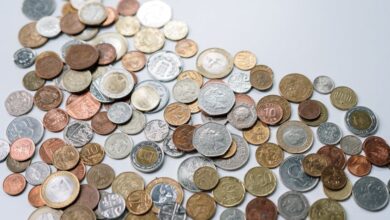Metals in Motion: Analyzing Industrial Demand, Investment Trends, and Market Influences

In an increasingly complex global economy, the dynamics of metal markets have become more significant than ever, reflecting both industrial needs and investment opportunities. Metals such as silver, copper, and rare earth elements play crucial roles not only in manufacturing and technological advancements but also in shaping investment strategies. As industries evolve and the push for sustainable practices intensifies, understanding the multifaceted nature of these metals is essential for investors and policymakers alike. This article delves into the intricate landscape of metal markets, exploring silver's dual role in industry and investment, the economic implications of copper price fluctuations, the rising demand for rare earth metals driven by green technologies, and the comparative investment potential of platinum and palladium. Additionally, we will examine how inflation influences metal prices, the future of aluminum in a sustainable economy, and the impact of mining regulations on market stability. By navigating these interconnected topics, we aim to provide a comprehensive perspective on how metals can serve as both a barometer for economic health and a strategic component in investment portfolios.
- 1. **Navigating the Dual Landscape: Silver's Industrial Applications and Investment Potential**
- 2. **Copper's Economic Pulse: Interpreting Price Movements as Indicators of Global Health**
- 3. **Rare Earths and Renewables: How Green Technologies Shape Demand and Market Dynamics**
1. **Navigating the Dual Landscape: Silver's Industrial Applications and Investment Potential**
Silver occupies a unique position in both industrial applications and investment markets, making it a versatile asset for various stakeholders. On the industrial side, silver is highly valued for its remarkable conductivity, thermal properties, and resistance to corrosion. It plays a crucial role in sectors such as electronics, photovoltaics, and medical devices. For instance, silver is a key component in solar panels, where it enhances energy conversion efficiency, driving demand as the shift toward renewable energy accelerates. Additionally, its antibacterial properties make it indispensable in healthcare applications, from wound dressings to sterilization processes.
On the investment front, silver is often viewed as a safe-haven asset, similar to gold, particularly during times of economic uncertainty or inflation. Investors frequently turn to silver to hedge against currency fluctuations and inflationary pressures, reinforcing its appeal as a store of value. The metal's relatively lower price compared to gold allows for greater accessibility for individual investors, contributing to its popularity in the investment community.
Navigating the dual landscape of silver's industrial and investment potential requires a nuanced understanding of market dynamics. Factors such as technological advancements, shifts in consumer preferences, and macroeconomic trends can significantly influence both demand and pricing. As industries increasingly adopt sustainable practices and seek to reduce their carbon footprints, the demand for silver in green technologies is expected to grow, further intertwining its industrial and investment narratives. Consequently, silver represents a compelling opportunity for investors looking to diversify their portfolios while tapping into the burgeoning markets driven by technological innovation and sustainability.
2. **Copper's Economic Pulse: Interpreting Price Movements as Indicators of Global Health**
Copper is often referred to as "Dr. Copper" due to its ability to reflect the overall health of the global economy. As a widely used industrial metal found in construction, electronics, and manufacturing, copper prices are sensitive to fluctuations in economic activity. When the economy is thriving, demand for copper typically rises, leading to higher prices. Conversely, during economic downturns or uncertainties, demand tends to decrease, resulting in falling prices.
The relationship between copper prices and economic indicators such as GDP growth, manufacturing output, and construction activity is well-established. For instance, an increase in infrastructure projects or housing developments directly boosts copper demand, driving prices higher. Similarly, robust manufacturing activity in major economies, especially those with significant industrial bases like China and the United States, often correlates with rising copper prices.
Additionally, geopolitical factors can play a significant role in copper price movements. Trade tensions, supply chain disruptions, or changes in mining regulations can all impact availability and pricing. For example, if a major copper-producing country experiences political instability, it may lead to supply shortages and increased prices, signaling potential economic strain.
Investors closely monitor copper prices as they can serve as a barometer for global economic sentiment. A sharp increase in copper prices may indicate optimism about future growth, while a decline could suggest looming economic challenges. As such, understanding the dynamics of copper pricing is essential for both market participants and policymakers seeking to gauge economic conditions.
3. **Rare Earths and Renewables: How Green Technologies Shape Demand and Market Dynamics**
Rare earth metals play a crucial role in the advancement of green technologies, driving significant changes in demand and market dynamics. These elements, which include neodymium, dysprosium, and lanthanum, are essential for manufacturing components used in renewable energy systems, such as wind turbines, electric vehicles (EVs), and energy-efficient lighting. As global efforts to combat climate change intensify, the demand for these metals is expected to rise sharply.
The transition to renewable energy sources is fundamentally reshaping the landscape of rare earth metal markets. For instance, the proliferation of electric vehicles has created a surge in demand for strong permanent magnets, which are vital for electric motors. Similarly, wind energy generation relies heavily on rare earth elements for the production of high-performance magnets used in turbine generators. As countries implement stricter emissions regulations and promote green technologies, the competition for these limited resources is becoming more pronounced.
Moreover, geopolitical factors further complicate the dynamics of the rare earth market. A significant portion of the world’s rare earth supply comes from China, which has historically controlled the majority of production. This dominance raises concerns about supply chain stability, prompting other nations to seek alternative sources and invest in domestic mining and recycling initiatives. As a result, market prices for rare earth metals can be volatile, influenced by shifts in policy, trade relations, and technological advancements.
In summary, the growing emphasis on renewable energy technologies is redefining the demand for rare earth metals, driving both innovation and competition within the market. The interplay of environmental policies, technological development, and geopolitical considerations will continue to shape the future of these critical resources in the green energy landscape.
In conclusion, the intricate web of metal markets reveals a complex interplay between industrial applications, investment opportunities, and broader economic trends. Silver stands out not only for its dual role in technology and finance but also as a valuable asset in diversifying investment portfolios. Meanwhile, copper prices serve as a critical barometer for global economic health, reflecting the underlying dynamics of supply and demand. As green energy technologies gain momentum, the demand for rare earth metals is expected to rise, highlighting their importance in the transition to a sustainable future.
The debate between platinum and palladium as investment choices underscores the shifting landscape of precious metals, influenced by market conditions and industrial needs. Additionally, as inflationary pressures continue to affect the prices of both precious and industrial metals, investors must remain vigilant and informed. The future of aluminum also holds promise in sustainable economies, as its lightweight properties and recyclability position it as a key player in various industries.
Finally, the impact of mining regulations cannot be overlooked, as they play a crucial role in shaping metal prices and availability. As we move forward, understanding these dynamics will be essential for investors and industries alike, ensuring informed decisions in a rapidly evolving marketplace.





